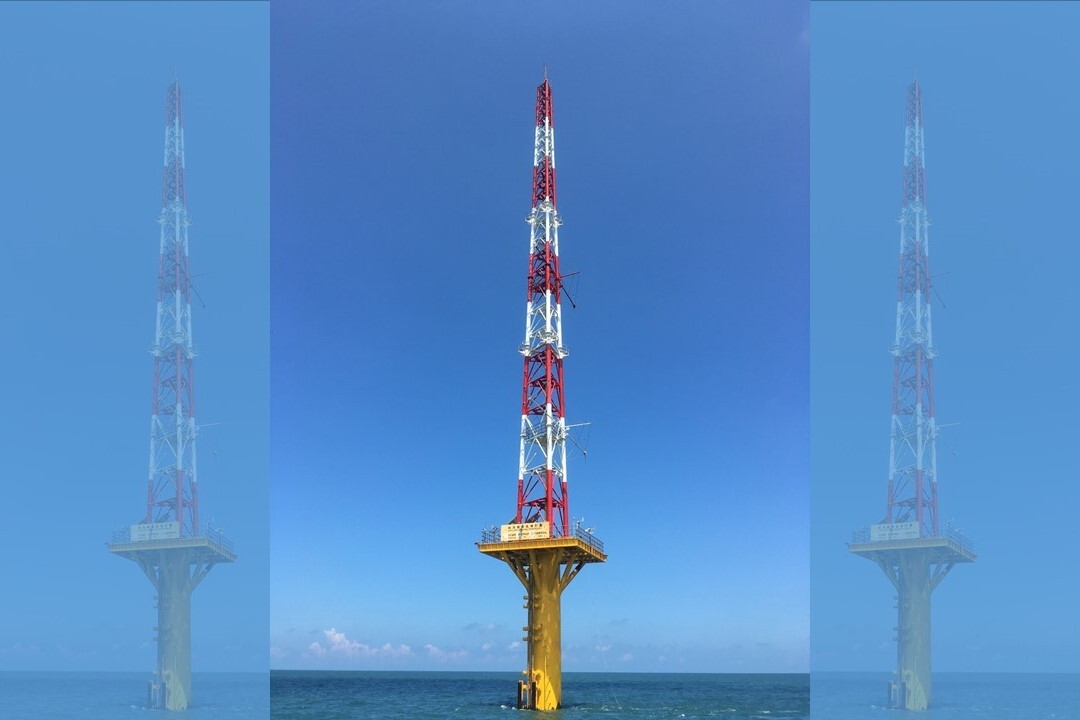Aligned with the Energy Transition and the National Satellite Program, NCKU’s Industry-Academic Innovation Marks a New Milestone.
Edited by Elysee Chung. Image credit to TGC and TASA.
Taiwan Generations Corporation (TGC), in partnership with the Taiwan Space Agency (TASA) and National Cheng Kung University (NCKU), is currently implementing an interdisciplinary initiative. This venture leverages TGC’s extensive expertise in the development of offshore wind power projects, coupled with NCKU’s longstanding research proficiency in Taiwan's surrounding sea waves, tidal currents, and coastal meteorological observations. With the incorporation of wind speed data from the recently launched “TRITON” satellite by TASA on October 9th this year, the project embarks on collaborative research between the university and industry, aiming to advance Taiwan's capabilities in wind energy forecasting for offshore wind fields.

the Fuhai Met Mast located 8 kilometers off the coast of Fangyuan Township, Changhua.
The three-party collaboration initiated in May 2020 when TGC and the Department of Aeronautics and Astronautics at NCKU signed a cooperation agreement. The primary goal was to conduct academic research related to atmospheric turbulence and wind energy, utilizing the Fuhai Met Mast located 8 kilometers off the coast of Fangyuan Township, Changhua. One of the projects involved installing Global Navigation Satellite System-Reflectometry (GNSS-R) equipment from TASA's TRITON on the Fuhai Met Mast. From September to October 2022, the research team gathered valuable observation data, including GNSS-R signals and real-time data on wind speed and wave height. They also conducted comparisons between GNSS-R signal retrieved wind speeds and actual measured wind speed, validating the feasibility of this research concept.

3D simulation of the Wind Hunter satellite
Based on available public research, there is presently no comparable method for observing sea surface wind fields. The conventional method involves utilizing aircraft-mounted GNSS-R for short-term observations. The Fuhai project's distinctive advantage lies in its capacity for long-term, all-weather observations. This enables the statistical analysis of observation results across various meteorological conditions, thereby enhancing the accuracy of wind speed retrieval.

Global Positioning System Reflection Signal Receiver
The realization of this research concept owes much to collaborative efforts between industry and academia. TGC contributed the prominent Fuhai Met Mast in Taiwan and a wealth of accumulated wind energy data. TASA provided the high-precision space-grade GNSS-R, with the project tasks executed by personnel from NCKU.
When the TRITON passes over the western coast of Taiwan, collaborative observations will take place between the satellite and the instruments on the Fuhai Met Mast. Valuable data from both the TRITON’s and Fuhai Met Mast’s GNSS-R, along with wind speed and wave height data, will be acquired. This invaluable data will then be integrated into the Wind Speed Retrieval model's database.
Established in 2015, the Fuhai Met Mast stands as Taiwan's first offshore marine meteorological observation tower. Over the past 8 years, TGC and its subsidiary, Fuhai Wind Farm Corporation, have consistently gathered comprehensive data on wind, sea, waves, and currents in the Changhua sea area. The information collected by the Fuhai Met Mast undergoes thorough evaluation and verification by third-party consultants, showcasing its reliability. This collaborative effort between industry and academia vividly highlights the significance of the Fuhai Met Mast and its collaboration with national satellite missions.
The members of this industry-academic research team possess expertise in various domains, including offshore wind energy operations and maintenance, satellite remote sensing, satellite navigation and communication, atmospheric turbulence, ocean engineering, and ocean-atmosphere interactions. After several years of collaboration, they possess excellent interdisciplinary project execution capabilities. It is anticipated that they will utilize wind speed data from the TRITON for academic research, contributing to the enhancement of Taiwan's offshore wind field wind energy forecasting capabilities. This advancement aligns with our country's commitment to sustainable energy and environmental preservation.
Provider:
NCKU News Center
Date:
2023-11-13